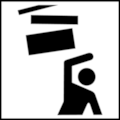Facts and data on pictograms

Synonyms / Other Terms Used
Danger from Above, Falling Ice, Roof Avalanche, Overhead Load, Suspended Loads
Category
Warnings, Safety Symbols
Message / Function
To warn of an overhead hazard: persons or things may be damaged by falling objects
| Source | Description | |
|---|---|---|
 B) B) |
ANSI Z535 | Box suspended at an angle from two ropes attached to a hook |
 |
CSS | Box suspended from two ropes attached to a hook |
 D) D) |
Collins 1983 | Two falling objects with motion streaks |
 |
Alamy | Human figure underneath falling objects with motion streaks |
 |
ISO 7010 | Upper human figure underneath falling black triangles with motion streaks |
 1) 1) |
ON Testdesign | Upper part of human figure with defensive arm movement underneath arrow pointing downwards |
 2) 2) |
ÖNORM A 3011 | Upper human figure with defensive arm movement underneath three rectangular objects |
 |
U.S. National Park Service |
Human figure, roof with wavy contour, several objects below edge of roof |
 |
ISO 7010 | Human figure, house with a roof, group of ice crystals in different sizes |
 C) C) |
Collins 1982 | Person wearing a hard hat, arrow depicting the path of the falling object, includig deflection at the hat |
 |
Herget | Arrow pointing downwards, bar broken into four pieces below |
 3) 3) |
Herget | Four rectangular objects, bar broken into four pieces below |
 A) A) |
Collins 1982 | Triangle pointing downwards inside circle |
Discussion
Some standards differentiate between distinct overhead hazards: for example in ISO 7010 one can find item W015 'Warning; Overhead load', W039 'Warning; Falling ice', and W040 'Warning; Roof avalanche'. And even the overhead load is displayed in several variations depending on the source. A closer look at the graphical symbols in the table above leads to the following categorization of the image contents:
Images covering four of these categories and labeled A) to D) were examined in research by Collins, Lerner, & Pierman (1982) and Collins (1983). While the abstract symbol A) from the bottom of the table above proved to be completely incomprehensable, about 60 % of the respondents identified B) as Overhead Hazard and another 35 % answered with Crane Load or Broken Cable. Image C elicited 51 % answers related to Overhead Hazard and 44 % responses like Wear Hard Hat. Results from the later comparison of B) and D) are unfeasible due to inadequate distractors in a multiple choice test, therefore overestimating comprehensibility of image D). The ISO 7010 and ANSI Z535 image used to warn of an overhead load was included in several studies (e.g. Vukelich & Whitaker, 1993, Ng et.al., 2011) and percentages of correct answers were always below ISO or ANSI recommendations. Answers for this variant usually have a strong focus on the crane load and are seen much less as warning of a general overhead hazard.
Wolff & Wogalter (1998) examined a set with a total of 33 safety-related symbols from several fields of application in a study concerning the impact of test methods as well as context on symbol comprehension scores. Diverging scores ranging from 39 % to 90 % were reported in this paper for the variant from Collins (1983), marked B) in the table above. Even regarding that the respondents in this study were mostly persons with higher education, this pictogram seems to be sufficiently comprehensible for the specific situation shown, but due to the image content general use appears unfavorable.
As the requirement to develop a pictogram for Overhead Hazard came up in the Austrian Standards Institute, it was decided to create a single pictogram to indicate a hazard from falling objects, disregarding details like falling ice, roof avalanches and the like. Brugger (1996) reviewed the three graphical symbols labeled 1) to 3) on basis of a Comprehension Test. Most respondents did not comprehend the rather abstract variant 3) correctly, and likewise almost 50 % offered a wrong or no response concerning variant 1). The posture of the human figure with defensive arm movement underneath an arrow pointing downwards was associated with gymnastics several times. On the contrary, the pictogram labeled as ÖNORM A 3011 elicited about 80 % answers related to an Overhead Hazard, with 15 % referring to a construction site.
Recommendations

Based on the test results known and regarding design aspects as well as legibility we recommend the use of pictogram No 118 from ÖNORM A 3011 part 7. This pictogram is well comprehensable and does not direct ones focus on a distinct overhead hazard and therefore does not limit general use.
Tests of pictograms of referent OverheadHazard
Brugger, Ch. (1990): Abschlußbericht über den Verständnistest. Report to the Austrian Standards Institute (ON) dated 10/90, Vienna.
Collins, B.L. (1983): Use of Hazard Pictorials/Symbols in the Mineral Industry. Washington, D.C.: National Bureau of Standards, NBSIR 83-2732, September 1983.
Wolff, J.S. & Wogalter, M.S. (1998): Comprehension of Pictorial Symbols: Effects of Context and Test Method. Human Factors 40 (2), 173-186.
See also
Updated 2024-12-04 by Ch.Brugger